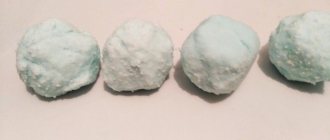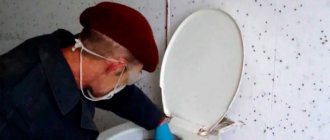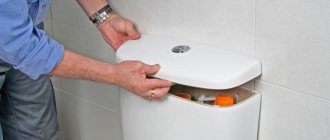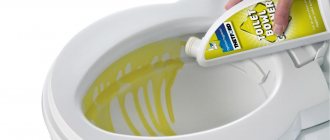During use, the brush loses its whiteness and an unpleasant odor appears. Bacteria and microorganisms begin to multiply intensively, which is harmful to human health. Cleaning the toilet with such a brush will not bring the desired effect, and from an aesthetic point of view it is an unpleasant sight. There are cleaning methods that will help return the brush not only to its former whiteness, but are also an excellent disinfectant. Knowing how to clean a toilet brush white can prevent the spread of bacteria and extend the life of the accessory.
How often should you wash your brush?
The toilet brush needs regular cleaning and replacement. It is stored only in a special stand, which is also washed periodically. You need to rinse the device with water and a cleaning agent after each cleaning of the toilet. Thorough soaking in solutions is required when the brush is obviously dirty or changes its color, but at least once a month.
The device must be changed once every 3-6 months. If no treatment is carried out, then more often - once a month.
Methods for cleaning a brush
Expensive and simplest devices need treatment - this is caused by the proliferation of microorganisms in the bristles. It is easy to wash the brush with professional preparations or folk remedies available at home.
Dish detergent
The advantage of this method is its simplicity and pleasant smell after processing, which lasts for a long time. The washing liquid should be poured into the brush holder, place the brush in it and soak for 10-12 hours. Then rinse the tools. This treatment can be carried out even daily.
Vinegar
The substance effectively eliminates yellowness and whitens stubble.
- Combine 100 ml of any cleaning product with 100 g of soda and a pinch of salt.
- Pour in 50 ml of vinegar (9%), 500 ml of boiling water. Mix thoroughly.
- Place the brush into the solution for 1-2 hours.
- Rinse the device under water.
Lemon acid
A solution combining vinegar and citric acid will effectively wash the brush.
- Combine 1 liter of water with 100 g of lemon.
- Add ¼ cup vinegar (9%). During the reaction, foam is formed that effectively dissolves stubborn dirt.
- Place the bristles in the container - it should take at least an hour.
- Treat the bristles under water.
Hydrogen peroxide
The substance is often used to remove limescale from a toilet bowl, but is also suitable for removing dirt from a brush.
- Dilute 50 ml of hydrogen peroxide in 1 liter of water. Mix.
- Place the bristles in the mixture for 1 hour.
- Rinse the device under running water.
If the contamination is ingrained, add 25 ml of ammonia to the solution, but then the treatment area must be well ventilated.
“Domestos”, “Silit”, “Toilet duckling”
Professional products cope well with dirt, but it takes at least 3 hours to keep the brush in the solution.
- Prepare a solution - combine 1 liter of warm water with 200 ml of product.
- Place the brush in a container and soak for 3 hours.
- Rinse under water.
It is better to soak in the open air (possibly on the balcony) due to the negative effects of product vapors on the body.
Materials of the nozzle and handle of the brush
There is a huge selection of these products, mainly inexpensive plastic kits are popular. You can purchase metal or ceramic toilet brushes. Some manufacturers produce holders made of silicone, stainless steel, and wood.
- The plastic model has a low price. The main disadvantage is the need to constantly change, as it ceases to perform its main functions.
- The metal device will serve its owner for a long time. This pen is easy to wash and does not accumulate germs and bacteria.
- A wooden holder does not have any advantages, the only advantage is that it is comfortable to hold in your hand.
You should not choose a product made from natural bristles, as this is not practical and simply impossible to clean the toilet bowl. The brush should be synthetic and hard, then you can easily remove dirt.
Recently, models made of silicone plates, which are arranged in a spiral or with a relief surface, have begun to appear. Such products are quite hygienic, as they clean well and are easy to wash under water.
Pollution Prevention
Preventive measures help preserve the freshness of the brush for a long time and increase its service life:
- It is undesirable to flush leftover food down the toilet - sticky, coloring, or high in fat content.
- After each treatment, rinse the bristles; do not store the device dirty.
- Before placing the brush in the stand, it is advisable to dry it. You can leave the device sandwiched between the lowered seat and the toilet for 20 minutes.
It is not difficult to remove dirt from the brush - after cleaning the toilet, just pour a special product into the drain and place the brush there for 1 hour. If the device is heavily soiled, special solutions and home remedies will restore freshness.
Basic methods
The following products are mainly used to clean brushes:
Table vinegar is no less effective in removing contaminants, which simultaneously suppresses the activity of pathogenic microorganisms: staphylococci, streptococci and others.
This procedure is recommended to be carried out at least once every three months. If necessary, you can clean the brush more often.
Chemicals
Regardless of the type of household chemical you choose, you can clean your toilet brush using one of the following methods:
- Pour the chemical into a container and place the toilet bowl cleaner there for several hours.
- Pour the liquid into the toilet and thoroughly clean the device using a brush.
- Pour the product into the glass in which the brush is stored and let it sit for at least 15 minutes. This cleaning option is considered more preferable.
Chemicals for household appliances are highly effective in combating dirt and pathogenic microorganisms. However, such products in concentrated form can be harmful to health. Therefore, when using household chemicals, it is recommended to use protective equipment: gloves, face mask, and so on.
Domestos
Domestos is considered the most common household chemical product. This product is able to clean surfaces with various types of contaminants and destroy bacteria. The main disadvantage of Domestos is that the liquid emits a pungent and unpleasant odor. Therefore, after applying the product, it is recommended to leave the toilet.
Silit
Silit, like Domestos, helps clean surfaces from various types of contaminants. Both products are comparable in effectiveness. Silite has a gel structure. This product, due to the hydrochloric acid included in the composition, is able to remove limescale and deposits.
Toilet bowl cleaner from Faberlic
A Fabelric brand product can clean a toilet brush white. The product is based on formic and oxalic acids, which, unlike the above liquids, do not emit a sharp, unpleasant odor.
Sarma
The Sarma gel-based cleaner is relatively cheap, but is not inferior in effectiveness to the above liquids.
Vinegar
To remove dirt from a brush, use a mixture of two tablespoons of salt and four tablespoons of soda. Both components are mixed until smooth. Then three tablespoons of vinegar and boiling water are added to this composition. The resulting liquid is poured into a glass with a brush and kept for 1-1.5 hours.
To enhance the effect, you can add a toilet bowl cleaner to the prepared composition and wash this device with this composition.
Detergent
You can also wash the brush using a mixture that includes:
- 2 tablespoons of detergent;
- a quarter glass of vinegar;
- half a glass of soda;
- 2 tablespoons of soda.
The resulting mixture is also diluted with water and then poured into a glass with a device for cleaning toilet bowls.
Traditional cleaning methods
As a rule, before cleaning the toilet brush, select an unnecessary container into which it will be convenient to pour the working solution. Baking soda, boiling water, salt, and vinegar may come in handy.
Features of using vinegar
Table vinegar does an excellent job of removing old stains, eliminating odors, and whitening. Pour a little of any available detergent into the container; it is only important that it is concentrated. 2 tbsp is introduced into it. l. salt and 4 tbsp. l. soda, mix thoroughly until the dry ingredients are completely dissolved. Pour in 3 tbsp. l. vinegar and boiling water, the liquid should completely cover the brush of the brush installed in the container. The instrument is left in the solution for an hour and a half, then rinsed under running water.
Vinegar - a home remedy for cleaning brushes
Simple bleach can also be effective here, but when using it, you need to ensure that vapors and drops of chemicals do not get on the skin and mucous membranes. Since the product has a pungent, unpleasant odor, when soaking the instrument in the holder, it is advisable to take it outside or to the balcony.
For weekly cleaning of toilet fixtures and brushes, you can pour the cleaning product directly into the toilet bowl, place a brush in it for half an hour and rinse everything together when flushing.
Preventive use of detergents
If there is a need for enhanced measures to maintain cleanliness, it is worth pouring homemade or store-bought cleaning product into the holder overnight and leaving the brush in it, rinsing it in the morning. In this case, you don’t have to worry about the spread of unpleasant odors and the proliferation of pathogenic microorganisms.
It is also recommended to periodically disinfect the brush using bleach, household chemicals, diluted potassium permanganate, and hydrogen peroxide. The selected product is poured into a container, the instrument is placed in it and left for an hour.
When using household chemicals, it is important to follow the manufacturer’s instructions on the label; when using aggressive mixtures, have personal protective equipment on hand in the form of a mask and gloves.
Disinfectants
Due to the fact that this device is constantly in contact with waste, it is recommended to periodically disinfect the brush. For this, both traditional methods and store-bought products are used.
White
Whiteness is distinguished by the pungent smell of chlorine, which is responsible for the disinfection of processed items. It is recommended to periodically soak the toilet accessory in this liquid for an hour.
Toilet duckling
Like white, Toilet Duck emits an unpleasant and pungent odor due to the fact that the liquid contains chlorine. However, the second remedy is considered more effective. Toilet duck is capable of destroying various pathogenic microorganisms.
Hydrogen peroxide
This affordable product is used to disinfect various items, including toilet accessories. Hydrogen peroxide is characterized by increased activity. In this regard, the toilet brush should not be washed frequently in this liquid.
Potassium permangantsovka
A solution of potassium permanganate copes well with staphylococcus and a number of other pathogenic microorganisms. Unlike peroxide, this product does not affect the toilet accessory. Therefore, a solution of potassium permanganate can often be used to disinfect household appliances.
How to store it correctly
To keep your toilet in good condition, and also to avoid the need for frequent washing of the toilet brush, you need to follow several recommendations:
- keep the accessory in the stand;
- place a stand next to the toilet to prevent water from splashing around the toilet;
- avoid contact of bristles with the floor and walls;
- After each use, rinse the bristles under water (you can during rinsing).
However, even if the above conditions and recommendations are met, the toilet accessory must be replaced every 5-6 months.
Source
Options for brush handles and attachments
Kvach is a special device made of synthetic fiber or silicone plates held on a stick. The length of the holder is half a meter and can be made of wood, metal, plastic, silicone.
They are usually sold as a set, consisting of a brush and a glass. It can be floor-standing or hanging, it all depends on the chosen model.
The following types of toilet brushes are available for sale:
- A round nozzle and a straight stick are a fairly popular type, they can be found in almost any store, and their cost is quite low. This model is available with a curved handle, but it is of little use, as it cleans poorly;
- The head has an oblong shape, and the pile is located on both sides. This device is convenient to clean, as it reaches hard-to-reach places. The only drawback is the brush, which is difficult to clean. The head must be washed thoroughly, or better yet, replaced after a month;
- Kvach made of silicone material. A practical thing, as there is no need to change it often. Cleans perfectly and dirt does not accumulate on the head;
- D-shaped brush made of silicone with a metal handle. Cleans the toilet well; after use, just rinse under water;
- The nozzle is in the form of a spiral, and the holder is flexible. Treats difficult places, easy to clean with a stream of water;
- Disposable kvacha. A hygienic option, as it must be thrown away after use.
Domestos cleaning product
It's no secret that Domestos is successfully used in household chemicals. It copes well with various contaminants on surfaces. You can wash a toilet brush with Domestos in the following way:
- The first step is to dilute the product in a bucket and place a brush there to clean the toilet for several hours.
- After this, you need to pour Domestos into the toilet and clean it thoroughly using a cleaning device.
- Again, the product is diluted in a bucket and a toilet brush is soaked in it for several hours.
It is recommended to leave the room in which soaking is taking place. This can protect you from inhaling harmful substances.
If you have an unnecessary brush lying around at home, you can rub the brush on it.
Why care for your brush regularly?
To ensure the hygienic cleanliness of the toilet, it is not enough to flush the water thoroughly; you must clean its surface with a special brush. Proper use allows you to remove not only biological contaminants, but also rust.
A toilet brush can contain several thousand varieties of bacteria and microbes. Not only will it lose its pleasant appearance, the brush will acquire a foreign odor and pose a potential threat to the health of all household members. This is why weekly cleaning of not only the toilet itself, but also the brush is so important.
Table vinegar
Oddly enough, regular table vinegar can also clean a dirty brush. This is the easiest way, since this product can be found in any kitchen. Using this method, you can easily make a brush white and also rid it of an unpleasant odor. It is recommended to adhere to the following algorithm:
- Pour any detergent in concentrated form into a medium-sized container. Add 100 grams of baking soda and 2 tablespoons of salt.
- When everything is dissolved, you need to pour in 50 ml of vinegar, then pour boiling water over everything. A brush is placed in this mass and placed there for one hour.
- After this, you need to rinse the device under water and evaluate the quality of cleaning.
Many people consider this method the most effective and cost-effective for cleaning an accessory. In addition to the brush, you can also clean the toilet tank with vinegar by simply pouring liquid into it. This way you can get rid of plaque on the walls.
Instructions for use, care and selection of toilet brushes
Probably everyone knows why a toilet brush is needed. At the same time, not everyone knows what they are, what materials they are made from, how to use them, and so on. It’s interesting that even for such a seemingly simple device as a toilet brush, there are entire instructions, which we’ll talk about today. We will try to tell you as much as possible about this device, which will greatly facilitate your further choice of accessory.
- 1 Types
- 2 Requirements for accessories 2.1 Rules of use
- 2.2 Storage and care
Assortment of standard plastic brushes
First, let's divide them depending on the material of manufacture. A modern toilet brush can be:
- Stainless steel, metal;
- Chrome plated;
- Ceramic;
- Plastic;
- Silicone.
Of course, the price directly depends on the material. So, you can easily find a simple toilet brush made of plastic for several tens of rubles, or you can purchase it for several tens of thousands of rubles. Yes, such models actually exist. Most importantly, when purchasing, you should focus not on price, but on quality. Cheap plastic will break quickly and will not last long. Metal models will allow you to forget what it’s like to buy brushes for many years. And if the metal is also of very high quality, the accessory will not lose its shine or visual appeal
And this is important
Now let's talk about the type of toilet accessory.
- Glass. This toilet brush is located in a special glass or container lying on the floor.
- Suspension. The accessory is hung on the wall, and a container is placed directly under it, into which all the water drips.
- Wall. The device is mounted on the wall, where there is a container for draining liquid.
The choice depends entirely on you, on the specific design solutions in the plumbing unit, and your needs in terms of physical capabilities. For example, it is difficult for older people to bend over, as a result of which a floor-mounted toilet brush will not work. Or small children use the toilet, and the brush is high on the wall. Also not an option. So think, reflect.
Recommendations for storage and use
If the housewife aims to keep the toilet in good condition, then it is necessary to regularly clean the brush or buy a new one.
If you store and use this device incorrectly, you will soon have to wash not only it, but the entire restroom. The brush must be used together with a stand. Therefore, it is necessary to take care of this. It is best to place the accessory close to the toilet and away from the walls. By following these simple recommendations, you can get rid of many problems that this household item can bring.
There are 4 basic rules that should be followed when using such a device. Their list is as follows:
- It is not recommended to store the accessory in a closed space. This speeds up the process of bacteria spreading.
- The brush should not touch the walls or floor.
- After each use, rinse the device under running water.
- It is best to clean or replace the device at least once a month.
How to keep your toilet brush clean
Good owners keep every room clean. And the toilet is no exception. The toilet must be cleaned regularly with detergent, brushes and a brush. This simple device helps get rid of dirt on the rim and inside of the toilet, from plaque and rust before it sets in. Don’t forget to keep the brush clean so you don’t have to buy a new one every two weeks.
Why is it important to keep your toilet brush clean?
First of all, a clean brush does not evoke feelings of disgust or disgust. With regular use, it begins to turn yellow and spread an unpleasant odor; millions of bacteria and microorganisms accumulate on it, which can cause diseases of the gastrointestinal tract or disorders in the respiratory system.
Brushes can be suspended or installed in a bowl. If the brush is suspended, there must be a container under it to collect liquid. The bowl should be wide, with smooth edges. And the optimal height between the brush and the container is 10-15 cm, so that water dripping from the brush does not splash on the walls and floor of the toilet.
A brush that sits in a bowl is less hygienic. All the liquid from it accumulates inside and with infrequent cleaning, bacteria or an unpleasant odor are formed. In this case, it is necessary to rinse the brush daily and drain it.
bowl the accumulated water.
Simple but easy ways to keep your brush clean
To clean the brush, any detergents that are used in home cleaning are suitable. But the most spectacular:
- Domestos – the line includes products with a neutral scent or lemon scent;
- Sarma is a gel that removes rust, plaque and copes with dirt;
- Toilet duck – perfectly disinfects, is inexpensive and has economical consumption;
- Chistin is another budget product that is suitable for any cleaning in the bathroom and toilet;
- Cillit Bang is a gel that fights plaque, rust and deposits on the brush and toilet.
Choosing the optimal model
Although there are quite a few different ways to clean a brush, it is still recommended to change it from time to time. It is best to choose an accessory based on personal preferences, as well as the structural features of the restroom:
- You should carefully study the handle of the object. Evaluate its convenience, as well as the material that was used in its manufacture. It is not recommended to purchase an accessory made of fragile materials.
- The fibers of the working part should be quite stiff. This increases cleaning efficiency.
- You can purchase a model that is disassembled.
- Don't forget about the aesthetic part. It is best to choose a model that fits perfectly into the interior.
By regularly cleaning a toiletry item and periodically replacing it with a new product, you don’t have to worry about the development of pathogenic bacteria in your toilet.
Source











